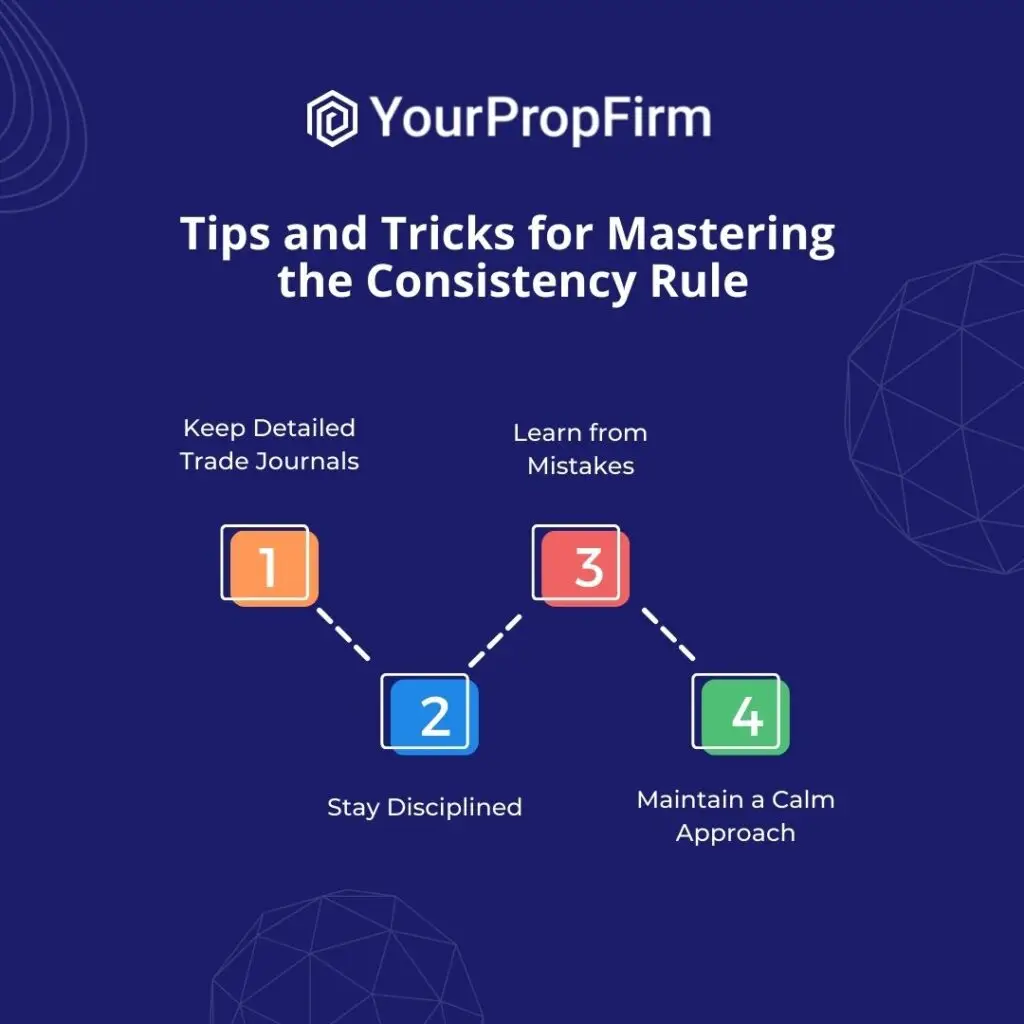Introduction to the Consistency Rule in Prop Trading
Prop trading firms often require traders to follow specific rules to ensure effective risk management and disciplined trading practices. One such requirement is the consistency rule, a key element in the prop trading landscape.
The consistency rule mandates that traders maintain a stable trading performance over a certain period. This involves avoiding large fluctuations in trade sizes, profits, and losses. The primary purpose of this rule is to manage risk and encourage disciplined trading. By following this rule, traders prove their ability to consistently generate profits without taking undue risks, which is essential for the firm’s risk management.
Benefits and Challenges
- Risk Reduction: The rule helps ensure traders do not take on excessive risk in pursuit of large profits, protecting the firm’s capital.
- Trader Discipline: It fosters a reliable trading strategy, encouraging long-term success and stability.
- Potential Profit Limitation: Some argue that the rule can limit a trader’s ability to capitalize on high-reward opportunities, potentially restricting overall profit potential.
- Adaptability Challenges: The rule can be challenging for traders who need to adapt quickly to changing market conditions, as it requires maintaining a consistent approach.
Understanding and navigating the consistency rule is crucial for traders in prop trading firms, balancing the need for risk management with the pursuit of profitability.
Understanding the Consistency Rule Regulations
The consistency rule includes several specific regulations that traders must adhere to. These regulations are designed to maintain stable trading performance and manage risk effectively.
- Trade Size Limits: Traders are required to maintain consistent trade sizes, avoiding significant fluctuations. This means keeping trade sizes within a specific range to ensure stability and predictability in trading activities.
- Minimum Trading Days for Withdrawals: Traders must trade for a minimum number of days before they are eligible to make withdrawals. This requirement ensures that traders demonstrate consistent performance over time rather than achieving short-term gains.
Key Components of the Consistency Rule
Daily Drawdown Limits
- Explanation: Daily drawdown limits restrict the maximum loss a trader can incur in a single day. This limit helps prevent significant losses that could jeopardize the trader’s account and the firm’s capital.
- Clarification: For example, if the daily drawdown limit is set at 5%, the trader must ensure that their losses do not exceed 5% of their account balance in any given day.
Trading Range Requirements
- Explanation: Traders must operate within a defined trading range, which specifies the minimum and maximum sizes of trades they can execute.
- Clarification: This component ensures that traders do not take on excessively large or small positions, maintaining a balanced approach to trading.
Average Lot Size Calculations
- Explanation: The consistency rule often includes calculations for average lot sizes, requiring traders to maintain an average position size within a specified range.
- Clarification: This means that over a period, the average size of the trades executed by the trader should fall within the defined limits, promoting consistency in trading activities.
Understanding these regulations and key components is crucial for traders to comply with the consistency rule, ensuring disciplined trading practices and effective risk management within prop trading firms.
Impact of the Consistency Rule on Trader Strategy
The consistency rule significantly influences how traders develop and implement their strategies within prop trading firms. Here are some key aspects of its impact:
Risk Management
The rule forces traders to adopt stringent risk management techniques. By imposing limits on trade sizes and daily drawdowns, traders must carefully plan their trades and avoid excessive risk, ensuring a stable trading approach.
Profit Limitations
The rule caps potential profits, impacting trader earnings. While it protects against large losses, it also restricts the ability to take advantage of high-profit opportunities, potentially limiting overall earnings.
Trading Style Adjustments
To comply with the consistency rule, traders must make necessary adjustments to their strategies. This may involve reducing trade sizes, adhering to strict risk management protocols, and maintaining a consistent trading approach regardless of market conditions.
Case Study: Real-Life Example of Navigating the Consistency Rule
Consider the case of Jane, a trader at a prop firm known for its stringent consistency rules. Jane had to adjust her trading style significantly. Initially, she focused on high-risk, high-reward trades, but the consistency rule required her to adopt a more balanced approach. She began implementing strict risk management techniques, ensuring her daily losses never exceeded the firm’s limits. By maintaining consistent trade sizes and focusing on steady, smaller profits, Jane successfully navigated the consistency rule, demonstrating stable performance and ultimately achieving her trading goals within the firm’s parameters.
The Role of the Consistency Rule in Funded Challenges
The consistency rule is a vital component in the different phases of funded challenges within prop trading firms. It ensures that traders maintain a stable and disciplined trading approach throughout the evaluation and verification processes, but its application changes once traders achieve live funded accounts.
Application During Funded Challenges
During the initial evaluation phase, traders must demonstrate their ability to maintain consistent trade sizes, profits, and losses. This phase assesses whether a trader can adhere to the consistency rule under testing conditions. In the verification phase, the consistency rule continues to be enforced to ensure that the trader’s performance remains stable and reliable. This phase further tests the trader’s discipline and risk management skills. Once a trader successfully passes the evaluation and verification phases, the consistency rule is generally relaxed or not applied to live funded accounts. At this stage, the primary focus shifts to real trading performance and profitability.
Evaluating Compliance with the Consistency Rule
Prop firms have specific methods for evaluating compliance with the consistency rule, and non-compliance can have significant implications. Firms monitor trade sizes, frequencies, and patterns to ensure that traders are adhering to the consistency rule. Automated systems often flag deviations from the expected trading behavior. Regular performance reports are generated to track a trader’s adherence to the consistency rule, highlighting any inconsistencies in trade sizes, profits, and losses. Periodic risk management audits are conducted to review a trader’s practices, ensuring that they are not taking excessive risks and are maintaining a disciplined approach.
Implications of Non-Compliance
Traders who fail to comply with the consistency rule may receive warnings or penalties, which can range from temporary trading restrictions to financial penalties. In severe cases, traders may be disqualified from the funded challenge. Non-compliance with the consistency rule can indicate a lack of discipline and risk management, leading to the termination of the trader’s participation. Some prop firms may require non-compliant traders to undergo additional training or retraining to improve their adherence to the consistency rule.
Strategies to Leverage the Consistency Rule for Profitable Trading
The consistency rule, while restrictive, can be used to enhance trading strategies and ensure profitable outcomes. Here are some effective approaches to leveraging this rule:
Planning and Execution
Effective planning is crucial for adhering to the consistency rule. Traders should set realistic profit targets and calculate permissible daily profits to avoid significant fluctuations. By planning trades with these limits in mind, traders can ensure that each trade aligns with the overall strategy and the consistency rule requirements.
Effective Risk Management
Risk management techniques that align with the consistency rule are essential for maintaining stable trading performance. Traders should diversify their portfolios to spread risk across different assets and markets. Additionally, using stop-loss orders can help control potential losses, ensuring they stay within acceptable limits and do not jeopardize the trader’s account or the firm’s capital.
Maintaining Consistent Trading
To maintain consistent trading without succumbing to the temptation of risky, high-profit trades, traders should focus on discipline and long-term strategy. Avoid the lure of high-reward opportunities that can lead to significant losses. Instead, stick to a well-defined trading plan that prioritizes steady, smaller profits over time. Regularly reviewing and adjusting the trading plan based on performance and market conditions can also help maintain consistency and adherence to the rule.
By implementing these strategies, traders can leverage the consistency rule to achieve profitable and sustainable trading outcomes within prop trading firms.
Tips and Tricks for Mastering the Consistency Rule

Mastering the consistency rule is essential for successful trading in prop trading firms. Here are some practical tips to help you achieve this:
1. Keep Detailed Trade Journals
Maintaining a detailed trade journal helps track your trading activities, strategies, and outcomes. By recording each trade, you can analyze your performance, identify patterns, and make informed adjustments to improve consistency.
2. Stay Disciplined
Discipline is key to adhering to the consistency rule. Develop a trading plan and stick to it, avoiding impulsive decisions that can lead to large fluctuations in your trading performance.
3. Learn from Mistakes
Learning from trading mistakes is crucial for mastering the consistency rule. After a bad trading day, review your trades to understand what went wrong and how you can avoid similar mistakes in the future. This reflective approach helps you grow as a trader and maintain consistency.
4. Maintain a Calm Approach
Staying calm and composed, especially after a bad trading day, is essential for consistent trading. Emotions can lead to impulsive decisions that violate the consistency rule. Practice stress management techniques and remind yourself of your long-term goals to stay focused.
By following these tips, you can master the consistency rule, ensuring disciplined and profitable trading within prop trading firms.
Frequently Asked Questions (FAQ)
How does the Consistency Rule affect day-to-day trading decisions in a prop firm?
The consistency rule limits the risk per trade, encouraging more cautious and calculated trading decisions. Traders must ensure their trades align with the firm’s risk management guidelines, promoting disciplined and stable trading practices.
What strategies can traders use to manage risk under the Consistency Rule?
Implementing stop-loss orders and keeping daily profits within the specified limits are effective strategies. These methods help control potential losses and ensure that trading activities remain within acceptable risk boundaries.
How can traders plan their trades to satisfy the Consistency Rule?
Traders should plan their trades by setting realistic profit targets and closely monitoring their trade size and frequency. This approach helps maintain consistency in trading performance, adhering to the rule’s requirements while pursuing steady and sustainable profits.
Conclusion and Further Resources
Adhering to the consistency rule offers key benefits such as improved risk management and more sustainable long-term profits. Effective risk management reduces significant losses, while disciplined trading leads to steady and sustainable profits.
Further Resources
For those looking to deepen their understanding of the consistency rule and its application in prop trading, here are some valuable resources:
Comprehensive Guide to Risk Management in Prop Trading
This guide covers essential risk management strategies, including position sizing and leveraging calculators. It offers insights into tools and practices that help traders manage their risk exposure effectively.
Analysis of the Consistency Rule in Prop Trading Firms
A detailed exploration of the consistency rule’s implications, including specific risk management protocols and account drawdown limits.
These resources offer detailed insights and practical advice on mastering the consistency rule, ensuring you can navigate the challenges and maximize the benefits of this essential trading requirement.




